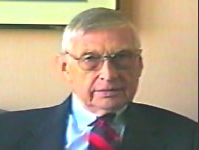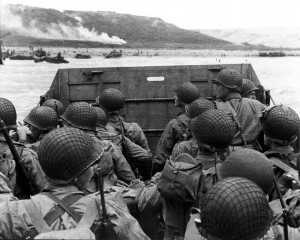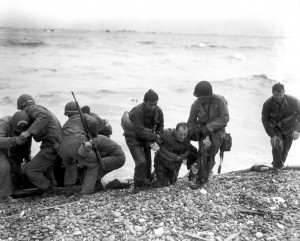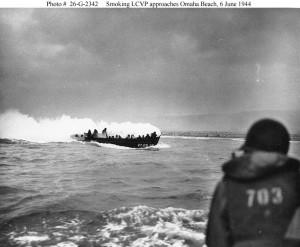“All of our leaders were gone. It was just — just a bunch of privates and sergeants and corporals trying to, you know, get something going and trying to get it to succeed…Nobody could possibly be trained for what we found that day. But you learn fast, you know. It’s a quick study when your life’s on the line.”
 John Robert Slaughter was a staff sergeant in Company D, 116th Infantry Regiment, 29th Infantry Division of the U.S. Army. In this interview with Martha Hopkins, Slaughter describes his experience landing on “one of the most difficult of all the landing areas on D-Day,” Omaha Beach:
John Robert Slaughter was a staff sergeant in Company D, 116th Infantry Regiment, 29th Infantry Division of the U.S. Army. In this interview with Martha Hopkins, Slaughter describes his experience landing on “one of the most difficult of all the landing areas on D-Day,” Omaha Beach:
John Robert Slaughter: …The 15th of April we left Ivybridge where we were stationed there in southern England and went over to Dartmouth, or near Dartmouth, where we had a — a camp set up called a marshaling area where we were getting ready to go across the Channel to the invasion of Normandy. And while we were in this marshaling area, we were incarcerated behind barbed wire and then we were told that we were going to spearhead the invasion of Normandy and that we were going to land on Omaha Beach, which was — we didn’t know at the time, but that — turned out it was one of the most difficult of all the landing areas on D-Day, and I guess my regiment probably lost more men that day than anybody.
Martha Hopkins: How many did they lose?
John Robert Slaughter: We lost 800.
Martha Hopkins: Out of how many?
John Robert Slaughter: Out of about — well, actually the assault troops, we probably had about 2,400 or something like that, about a third of our forces.
Martha Hopkins: And when you say lost, you mean that many were killed or killed and wounded?
John Robert Slaughter: Killed and wounded. I don’t think we had anybody that was captured on D-Day that I know of, but we did have — and more — we had more kills than we did wounded, because most of the men that got wounded died of their wounds because we couldn’t get — you know, couldn’t get first aid to them, so many of them that ordinarily would be saved bled to death or went into shock or whatever. But we landed right at the Vierville draw, which A Company landed first and they lost 91 men killed and most of the rest of the company was wounded except maybe about 15 I think were able to continue at the end of the day.
Martha Hopkins: What was it like coming in?

American assault troops approaching Omaha Beach. (June 6, 1944). Source: U.S. National Archives, # SC 320901.
John Robert Slaughter: Well, the water — you know, the sea was very rough and everybody got seasick and we were soaking wet, cold and miserable. It was June, but it was — it felt like November, December because it couldn’t have been much more than fifties, the temperature, and we were wet anyway and the wind blowing and it was just — everybody was shivering and very cold. Over to our right about half a mile or so the Battleship Texas was — had turned broadside, and it was dark when we, you know, disembarked from the Empire Javelin and we were — we were on — we were let down to the sea by davits. We were on a British ship and the other two battalions of the 116th were on British — on American ships, but the British had LCAs instead of LCVPs. We –
Martha Hopkins: How were they different?
John Robert Slaughter: Well, the difference was they were a little wider and lower, and I think they were a better landing craft than the LCVP. The LCVP was a — was made of plywood, too, and I think these are a little bit more substantial than that. We had about a — I guess maybe a half inch armor on the — for the ramp. When the ramp went down, of course, it was our method of getting off the ship, off the boat, carried 30 men, and –
Martha Hopkins: It would make trips back and forth to get –
John Robert Slaughter: Well, I’m sure most of them didn’t make but one trip because most of them didn’t get back. I think ours was hit as it — after we were let off, it limped — they had to back out and get back in, you know, and somebody told me that it was — it was hit and sunk, but we — we were under fire all the way. When we got, you know, two, three hundred yards from shore we started taking artillery and mortars, and then as we got closer in and we — and the ramp went down, that’s when the small arms opened up. And they cut us down pretty good. The men — some of the men couldn’t swim and we were carrying 60 pounds of equipment or weapons, and most everybody had to dump their loads in order to get in, you know, and it was — it was a tough deal…
John Robert Slaughter: But, anyway, we — when we got to the — I just worked my way in. I went into the water, you know, first, because the first man off of our landing craft was — he was hit in the head with the flailing ramp, it hit him in the head and killed him, so the rest of us went off to the sides. And I just went into the water. There’s no way that we could have gone straight to the beach and crossed and up on the bluffs like they told us we were supposed to do, so we just — I just stayed in the water and kept my head, you know, just above the water until I got — until I could see, you know, that things were calming down a little bit.
Martha Hopkins: Were there waves and everything, too, hitting you?
John Robert Slaughter: Oh, yeah. Oh, yeah. There was six feet tide, you know, that would crash over you and then, you know, you would be underwater, then you’d be over and then it’d be down to your waist and it was up and down, up and down. And people were screaming, hollering, you know, drowning, some hit, bleeding, and it was — they were hanging all over me trying to stay — stay afloat, their head above water, and they were pulling me under and I was — you know, it was terrible. And finally worked my way, you know, to the edge of the water and I just waited. The first man I saw trying to cross the beach was hit just about 25 yards — the beach was about 400 yards of flat sand, because we landed at extreme low tide. The beach had land ops, had landing obstacles on the beach.
Martha Hopkins: Now, those are things like we saw over there yesterday?
John Robert Slaughter: That was — that was the hedgehogs.
Martha Hopkins: Those sort of –
John Robert Slaughter: Where we landed there were more telephone pole like things. They were — had a bipod and they were facing the — and they were facing the ocean like this and the big Teller mine sitting on top, and they were designed to snag a landing craft in high tide. If we had landed in high tide, they would have been submerged and you couldn’t see them and then you’d hit one of those mines and blow up. The hedgehogs were designed to snag the bottom of the landing craft and knock a hole in it.
But, anyway, we landed at extreme low tide, so all those were exposed and we could see them and avoid them. But the first person I saw running across the beach started stumbling and he was shot and he fell and he started screaming for a medic, and one of our medics went over to help him, and the medic was also shot and both of them screaming, and finally both — within five or six minutes, they died, both of them, and so that put a chill in my thinking.
You know, I was getting ready to run across and then I thought I’ll wait a minute, so I waited a little while till the machine guns died down a little bit and then I — my squad was around me, two or three of them were. I told them I was going to take off and follow behind me, so I started running as fast as I could and as low as I could, and I started stumbling and I had my rifle with a bullet in the chamber and the safety off and my bayonet was fixed and I was ready — you know, I thought I was going — I didn’t know what I was going to run into.
And I started stumbling, you know, through a little run of water and I almost stumbled and fell, but I didn’t, and I accidentally fired my rifle, and that scared me because I was — happened to be out in front, so nobody in front of me was shot or anything. But, anyway, I just started running, just kept running until I got to the seawall, which was about two-thirds of the way across the beach, and it was about five or six feet high, and there was a promenade road over this wall. And so I got behind the wall and I was going to take my raincoat off to clean my rifle because it became full of sand and water and it wouldn’t fire after it jammed, after it fired and jammed. And so I — I took my raincoat off to spread that out to clean my rifle, and my raincoat was full of bullet holes. I didn’t realize that we had been under fire all the way across.
Martha Hopkins: But you didn’t get hit?
John Robert Slaughter: No, I didn’t get hit. And so I caught my breath there at the seawall and my number one gunner and number two gunner right behind me and the rest of them were still back at the water’s edge, and so I caught my breath and we continued on to the end of the — till we got across the beach, and we got in behind the sand dune and we had a — we lost our machine gun. We had a — we had a tripod and a box of ammo and no — nothing with it to fire, so we just stayed there right next to this sand dune right at the foot of the cliffs, the bluffs, and, you know, just kind of waited until some of the other people got across the beach, found somebody from H Company who had a gun, no tripod; we had a tripod and no gun, so we put them together and we had a gun and had one box of ammo.
And we could see this pillbox firing, you know, down on the beach about ten o’clock from where we were. And so my number one gunner started, you know — started firing on this pillbox. And we could tell that it was indirect fire, he wasn’t watching his target. He was — probably had a periscope or something he was looking through or aiming through something, but he didn’t have the exposure to it.

Crossed rifles in the sand are a comrade’s tribute to this American soldier who sprang ashore from a landing barge and died on Omaha Beach. (June 6, 1944). Source: U.S. National Archives, #26-G-2397.
But, anyway, we were — I could see the tracer bullets ricocheting in the opening of the pillbox, but they kept firing the 88, it’s an 88 that they were firing out of there, and so we finally had to move our guns in and we had to move our position. And then we — at the foot of the hill we saw a dead sailor laying head first down the hill and he was an officer and he had a big radio on his back, and so I didn’t pay much attention to it. We found a path going up the — up the bluff with mines on both sides and there was white tape, that the Germans had used this path to — for the workers to work on the fences, and so we — we went up this path and — and met with the first sergeant of B Company and two or three of his men and I had three or four of my men by then, and so that was our — our little band of brothers, so to speak.
And so we went up on top of the hill. And as soon as we got up on the hill, I could see this Nebelwerfer firing, we called it screaming meemies. It’s a six-barreled mortar and it’s fired electronically. And he was just plastering the beach, and it looked like it was about a hundred yards from where we were. We didn’t have anything to knock it out with, so Presley, the first sergeant of B Company, remembered that radio down on the bottom of the hill, and we sent one of the men down to get it, brought it up and found out there was a destroyer on the other end of it, and he had the destroyer fire a couple of rounds and got to see where he was and then he just walked it in to where the Nebelwerfer was and he fired perfect and knocked it out with that, so that was a tremendous thing that he did.
Later that afternoon we went back down to the beach to get — our mission was to get up on the hill as quickly as possible and dig in and get ready for the counterattack that we felt was coming, so we didn’t have very many weapons and very much ammo and not many men, so I went back down on the beach to try to get — you know, to round up some people and try to get more automatic weapons up there.
Martha Hopkins: Wasn’t that pretty scary to go back down there, because I guess they were still firing down there?
John Robert Slaughter: Well, they were still — but it was scary up where I was anyway. I mean we were getting shot at up on the hill too, I mean, you know, so we had to go back and get some ammo. We didn’t have any weapons. So I went back down, and that’s when I saw — the tide had already come in by then and it was just washing up all these dead GIs. I could tell then that we were really in bad shape because it looked like the whole regiment was just about wiped out, and all I could see down on the beach was dead men and wounded men, and very few, you know, healthy people.
And we did find a few weapons. There were all kinds of debris down on the beach. We picked up a few and took them back up the hill. But, anyway, that’s the way we — that was our D-Day. I looked out over the Channel, I could see all those 5,000 ships out there. It was an awesome sight. That gave us a little bit of courage, but I thought sure we were going to get pushed back into the ocean because we didn’t have enough — we didn’t have enough men to — to do anything with and we weren’t organized at all.
All the officers, just about, were killed, most of the sergeants. We had — out of my company, we had — five of nine of our officers were killed including the captain; ten of the sergeants including the first sergeant was killed, two corporals, so all of our leaders were gone. It was just — just a bunch of privates and sergeants and corporals trying to, you know, get something going and trying to get it to succeed.
Martha Hopkins: Had you been trained well for what was going to happen?

American landing party helping out on Omaha Beach, France. (June 6, 1944). Source: Center of Military History.
John Robert Slaughter: Oh, yeah, but not for that, no. Nobody could possibly be trained for what we found that day. But you learn fast, you know. It’s a quick study when your life’s on the line, so we — we finally organized a little bit. And the next morning, by the next morning we started moving inland and getting on down toward Pointe du Hoc. We went through Vierville and then down to Pointe du Hoc and then we relieved some Rangers down there who had been trapped, and then we went from there to Grandcamp, from Grandcamp to Maisy and then on up to Couvains and then towards Saint Lo.
Martha Hopkins: Now, were you being fired on by Germans all the way?
John Robert Slaughter: Just about. Oh, yeah, yeah, they were — see, they were — had defensive depths. Not only did they have a defensive line right at the beach, but they also had — they’d go back several hundred yards and they’d set up another defensive line and then another one behind that, so, you know, we were hitting — then we got into the hedgerows, and then that was another obstacle that we had a terrible time with.
Martha Hopkins: You weren’t prepared, hadn’t been warned about the –
John Robert Slaughter: We were not prepared for the obstacles — I mean the hedgerows, no. They were — we were very well trained about the beach and the pillboxes and how to — you know, how to neutralize barbed wire and mines and so forth, but the hedgerows were strange to us. We didn’t know how to operate with them until — almost we were out of them before we actually learned how to use them.
And when we took Saint Lo the 18th of July, we — by then we were — somebody had invented these, you know — took the jack rocks or whatever you call those hedgehogs and made, you know, prongs on the front of the tanks, they welded them on the front of the tanks so they could push through the hedgerows. That helped us a lot when we could get their tanks, you know, to help support the infantry.
I got wounded on the 5th of July in the hedgerow. I was — a sniper shot me through my helmet, hit — blasted through my head. And then on the 7th of August up to Vire I got a piece of shrapnel in the back and went back to England for — from August the 7th until October the 10th. And then I was shipped out back to — back to the outfit. We were then up to the German border, Aachen, and then I stayed with them the rest of the way…
Find the full transcript of the interview with John Robert Slaughter here.
Comment |

 Share on Facebook
Share on Facebook
 Tweet
Tweet
 Add My Story
Add My Story







